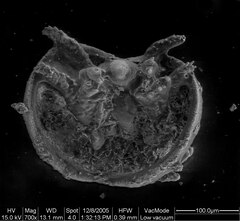TheOrsten faunaare fossilized organisms preserved in theOrsten lagerstätteofCambrian(LateMiaolingian[1]toFurongian) rocks, notably atKinnekulleand on the island ofÖland,all inSweden.
| Orsten | |
|---|---|
| Stratigraphic range: | |
 Hesslandona angustata,aphosphatocopine,showing exceptional preservation in 3D | |
| Type | Geological formation |
| Unit of | Alum Shale Formation |
| Lithology | |
| Primary | Shaleandlimestone |
| Location | |
| Region | Kinnekulleand island ofÖland |
| Country | Sweden |
| Type section | |
| Named for | Orsten[a] |
| Named by | Klaus J. Müller,1975 |
The initial site, discovered in 1975 byKlaus Müllerand his assistants, exceptionally preserves soft-bodied organisms, and theirlarvae,who are preserved uncompacted in three dimensions. Thefossilsarephosphatizedandsilicified,thus the delicatechitinouscuticle and soft parts are not affected by acids, which act upon the limestonenoduleswithin which the fossils have survived. Acids dissolve the limestone, revealing themicrofossilsin a recovery process called "acid etching". To recover the fossils, more than one and a half tons of Orsten limestone have been dissolved in acid, originally in a specifically designed laboratory inBonn,more recently moved toUlm.The insoluble residue is scanned byelectron microscope.[2]The phosphorus used to replace the fossils with calcium phosphate is presumed to be derived from fecal pellets.[3]
The Orsten fauna has improved the understanding ofmetazoanphylogenyandevolution,particularly among thearthropods,thanks in part to unique preservation of larval stages. The Orsten sites reveals the oldest well-documentedbenthicmeiofaunain the fossil record. For the first time, fossils oftardigrades( "water bears" ) and apparently free-livingpentastomidshave been found.
The Cambrian strata consist ofalumshaleswith limestone nodules (theAlum Shale Formation), which are interpreted as the products of an oxygen-depleted ( "dysoxic" )[b]marine bottom water habitat of a possibly offshore seashelf at depths of perhaps 50–100 m.[2]The bottom was rich in organic detritus, forming a soft muddy zone withflocin its surface layer.
Other Orsten-type preservation fauna have been found in Nevada, eastern Canada, England, Poland, Siberia, China and theNorthern Territoryof Australia.[4]
Paleobiota
editBased on data from C.O.R.E. website.[2]
| Animals | |||
|---|---|---|---|
| Genus | Notes | Images | |
| Agnostus | Anagnostid | ||
| Cambropycnogon | A larvalsea spider | ||
| Cambropachycope | A monocular arthropod of uncertain affinities, possibly placed in stem-Mandibulata | ||
| Goticaris | A monocular arthropod of uncertain affinities, possibly placed in stem-Mandibulata | ||
| Rehbachiella | A pancrustacean | ||
| Martinssonia | A pancrustacean | ||
| Dala | A pancrustacean | ||
| Musacaris | A pancrustacean | ||
| Bredocaris | A pancrustacean | ||
| Skara | A pancrustacean | ||
| Sandtorpia | A pancrustacean | ||
| Henningsmoenicaris | A pancrustacean | ||
| Walossekia | A pancrustacean | ||
| Aengapentastomum | Apentastomidparasitic crustacean | ||
| Boeckelericambria | |||
| Heymonsicambria | |||
| Haffnericambria | |||
| Oelandocaris | A stem-group crustacean or stem-groupmandibulateormegacheiran[5] | ||
| Hesslandona | A bivalved arthropod belonging toPhosphatocopina | ||
| Trapezilites | |||
| Waldoria | |||
| Veldotron | |||
| Falites | |||
| Vestrogothia | |||
| Orstenotubulus | Alobopodian | ||
| Arthropoda indet. | Severalnauplius-like larvae that cannot be associated with any of the other arthropods. The various larvae have been termed A1, A2, B and C.[6][7]Formerly included among them was “larva D”, nowCambropycnogon. | ||
Orsten-type fauna found elsewhere
edit| Animals | |||
|---|---|---|---|
| Genus | Notes | Images | |
| Skara | Two additional species known from Poland and China | ||
| Heymonsicambria | One additional species known from Ordovician of Canada | ||
| Vestrogothia | Two additional species known from China | ||
| Markuelia | A possible member ofCycloneuralia,known from Australia | ||
| Shergoldana | |||
| Orstenoloricus | Aloriciferanlarva[8]from Australia | ||
| Austromarrella | Amarrellomorphfrom Australia | ||
| Cambrocaris | A crustacean, known only from Poland | ||
| Unnamedtardigrade | Only known from Siberia | ||
| Wujicaris | Apancrustaceanknown from China | ||
| Yicaris | |||
| Dabashanella | A member ofPhosphatocopinafrom China | ||
| Klausmuelleria | A member of Phosphatocopina from England | ||
Notes
editReferences
edit- ^Maas, A.; Mayer, G.; Kristensen, R. M.; Waloszek, D. (2007). "A Cambrian micro-lobopodian and the evolution of arthropod locomotion and reproduction".Chinese Science Bulletin.52(24): 3385.doi:10.1007/s11434-007-0515-3.S2CID83993887.
- ^abcC.O.R.E. Örsten site
- ^Maeda, Haruyoshi; Tanaka, Gengo; Shimobayashi, Norimasa; Terufumi, Ohno; MATSUOKA, HIROSHIGE (2011-03-30)."Cambrian Orsten Lagerstätte from the Alum Shale Formation: fecal pellets as a probable source of phosphorous preservation".PALAIOS.26(3/4):225–231.doi:10.2110/palo.2010.p10-042r.JSTOR25835620.S2CID131428775.
- ^Waloszek, Dieter (19 February 2016)."'Orsten' on World-Wide Scale ".Center of 'Orsten' Research and Exploration.Retrieved29 November2016.
- ^Aria, Cédric; Caron, Jean-Bernard; Gaines, Robert (2015). Zhang, Xi-Guang (ed.)."A large new leanchoiliid from the Burgess Shale and the influence of inapplicable states on stem arthropod phylogeny".Palaeontology.58(4):629–660.doi:10.1111/pala.12161.S2CID86443516.
- ^Müller, Klaus J.; Walossek, Dieter (1986)."Arthropod larvae from the Upper Cambrian of Sweden".Earth and Environmental Science Transactions of The Royal Society of Edinburgh.77(2):157–179.doi:10.1017/S0263593300010804.ISSN1473-7116.
- ^Walossek, Dieter; Müller, Klaus J. (1989)."A second type A‐nauplius from the Upper Cambrian 'Orsten' of Sweden".Lethaia.22(3):301–306.doi:10.1111/j.1502-3931.1989.tb01345.x.ISSN0024-1164.
- ^Peel, John S.; Stein, Martin; Kristensen, Reinhardt Møbjerg (2013-08-09)."Life Cycle and Morphology of a Cambrian Stem-Lineage Loriciferan".PLOS ONE.8(8): e73583.doi:10.1371/journal.pone.0073583.ISSN1932-6203.PMC3749095.PMID23991198.